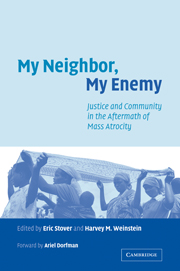Book contents
- Frontmatter
- Contents
- List of contributors
- Foreword by Ariel Dorfman
- Acknowledgments
- Introduction: conflict, justice and reclamation
- Part I Institutional approaches to justice
- Part II Social reconstruction and justice
- Part III Survivors and justice
- Conclusion: a common objective, a universe of alternatives
- Index
Part II - Social reconstruction and justice
Published online by Cambridge University Press: 05 May 2010
- Frontmatter
- Contents
- List of contributors
- Foreword by Ariel Dorfman
- Acknowledgments
- Introduction: conflict, justice and reclamation
- Part I Institutional approaches to justice
- Part II Social reconstruction and justice
- Part III Survivors and justice
- Conclusion: a common objective, a universe of alternatives
- Index
Summary
How do multi-ethnic communities torn asunder by war and communal violence remember the past? Do they become mired in feelings of betrayal and revenge? What should children be taught about human rights, tolerance, the recent wars, and the history of their country? Do trials of suspected war criminals make a difference? What will it take for divided communities to live together again in peace? These are the questions that the authors in Part 2 address.
Rebuilding a post-war society involves repairing both its physical infrastructure and social fabric. While physical reconstruction suggests a coherent process similar to the rebuilding of a city after a natural disaster, the process of social reconstruction presents a far more challenging and complex task. This process takes place at all levels of society and entails constructing social networks, renewing old relationships, working with former enemies, and setting common goals that will benefit all citizens. In the opening two chapters of Part 2, Dinka Corkalo et al. and then Timothy Longman and Théonèste Rutagengwa examine the process of social reconstruction through the lens of collective memory. Using data collected from qualitative studies in Rwanda and the countries of the former Yugoslavia, they describe how ethnicity molds collective memory, and how governments and nationalist discourses influence that process. The authors provide accounts by ordinary people of what it is like to rebuild a community in an environment of on-going ethnic and nationalist manipulation.
- Type
- Chapter
- Information
- My Neighbor, My EnemyJustice and Community in the Aftermath of Mass Atrocity, pp. 141 - 142Publisher: Cambridge University PressPrint publication year: 2004

